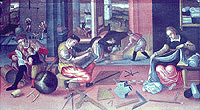
The Measurers:
a Flemish Image of Mathematics in the Sixteenth Century
Catalogue
The Mathematicians
1 2 3 4 5 6 7 8 9 10 11 12
The Measurers
13 14 15 16 17 18 19 20
21 22 23 24 25
26 27 28 29 30 31 32 33 34 35 36 37
38 39
The Collectors
40 41 42 43 44 45 46 47
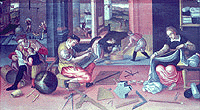 1. The Measurers
1. The Measurers
Flemish
Second half of the sixteenth century
Oil on panel
Dimensions: 525 x 293 mm
Accession no. 33-73
2. Cosmographia, sive descriptio universi orbis
Authors: Peter Apian and Gemma Frisius
Printed at Antwerp, in 1584





3. De astrolabo catholico
Author: Gemma Frisius
Printed at Antwerp, in 1556
Gemma is described on the title-page as 'Medici ac Mathematici'. The dedication to Charles V
is dated at Louvain, October 1555.
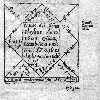


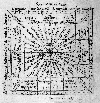
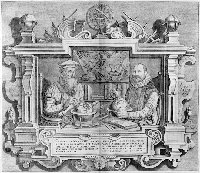 4. Gerardus Mercator and Iudocus Hondius
4. Gerardus Mercator and Iudocus Hondius
An engraved plate from a Hondius edition of Mercator's Atlas, representing the
'partnership' between the two great cartographers. As the plate records, both were dead by the
time of this edition.
Dimensions: 447 x 386 mm (plate impression)
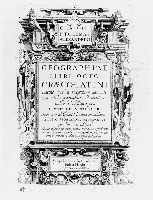 5. Mercator & Hondius edition of Ptolemy's Geographia
5. Mercator & Hondius edition of Ptolemy's Geographia
Printed at Amsterdam, in 1605
An historical atlas edited by Mercator and published by Hondius, being an edition of Claudius
Ptolemy's Geographia dealing with the Gręco-Roman world. The title reads
Geographiae libri octo Gręco-Latini. Latinč primłm recogniti & emendati, cum tabulis
geographicis ad mentem auctoris restitutis per Gerardum Mercatorem, and the imprint
Sumptibus Cornelij Nicolai & Iudoci Hondij.
After the map of the world known to Ptolemy, the first regional map is of 'Hibernia' and 'Albion
Britanni'. Opened at the map of 'Sardinia' and 'Sicilia', a finely engraved plate with ships and
sea-monsters and an elaborate cartouche incorporating an armillary sphere and a globe or
planisphere.
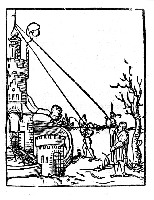 6. Annuli astronomici
6. Annuli astronomici
Author: Pierre Beausard
Printed at Antwerp, in 1553
Beausard's account of the astronomical rings, on which Gemma had published a tract in editions
of the Cosmographia from 1539 and elsewhere. Beausard was born at Louvain, where
he signs the dedication to this book, and became Professor of Mathematics in Antwerp. He
acknowledges his local precursor as 'noster candissimus Gemma'.
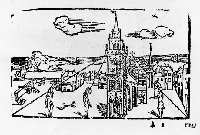 7. De annuli sphęrici fabrica et usu
7. De annuli sphęrici fabrica et usu
Author: Jean Taisnier
Printed at Antwerp, in 1560
Another Antwerp edition of a practical account of the astronomical rings.
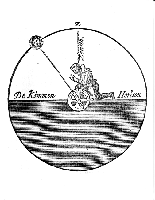 8. De genuino usu utriusque globi tractatus
8. De genuino usu utriusque globi tractatus
Author: Adriaan Metius
Printed at Franecker, in1624
An account of the celestial globe and the construction of sundials, and (with separate pagination)
of the terrestrial globe and the art of navigation.
9. Fundamentale onderwysinghe
Author: Adriaan Metius
Printed at Amsterdam, in 1627
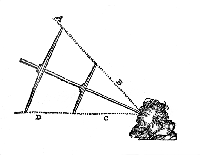 10. Primum mobile, astronomice, sciographice, geometrice, et hydrographice ...
Editio nove, ab innumeris mendis vendicata, et instrumentis mathematicis aucta ą
Guilielmo Blaeu
10. Primum mobile, astronomice, sciographice, geometrice, et hydrographice ...
Editio nove, ab innumeris mendis vendicata, et instrumentis mathematicis aucta ą
Guilielmo Blaeu
Author: Adriaan Metius
Printed at Amsterdam, in 1633
A book in Dutch on the celestial globe, the astrolabe, the solution of spherical triangles and
dialling.
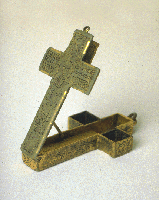 11. Cruciform sundial
11. Cruciform sundial
Signed: A. Zeelsti[us] faciebat Louanij
Dated: 1588
The cruciform dial is a special case of the polyhedral dial with, of course, devotional
significance; as is usual, this instrument depicts the Crucifixion on the front. The brass body of
the cross is propped at an angle set by a latitude scale - 'Gradus latitudinis loci' - on the base, so
as to act as a polar dial, with hour lines engraved on different faces of the cross. Latitudes of 12
places are recorded on the instrument. In addition to several instruments elsewhere, Adriaan
Zeelst is also known for a book on the astrolabe written with Gerard Stempel of Gouda (see
catalogue no. 12).
Length: 55 mm
Lewis Evans Collection G. 495
12. Utriusque astrolabii tam particularis quam universalis fabrica et usus
Authors: G. Stempel and A. Zeelst
Printed at Ličge, in 1602
The authors associate the 'particular' astrolabe with Johann Stöffler and the 'universal' with
Gemma Frisius. It has been suggested that the instrument maker Zeelst was responsible only for
engraving the plates (Rooseboom, p.133) but he is partnered with Stempel on the title-page and
in signing the dedication.
13. Polyhedral dial
Signed: M.C.K.C.R.P.
Dated: 1691
A German instrument in brass with seven faces and seven dials, projected for latitude 47 degrees
30 minutes.
Length: 152 mm
Lewis Evans Collection G. 565
14. Horary quadrant
17th century?
An English quadrant of an unusual design, for finding the time from the altitude of the sun, with
two fixed sights, a plumb-line and sliding bead. Any altitude can be taken with the degree scale
on the rim. This text needs to be extended a little so that it moves onto this next line and th next
and the next.
Radius: 200 mm
Billmeir Collection
Accession no. 57-84/194
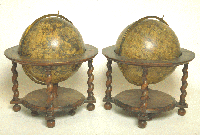
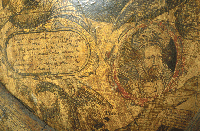
15. Pair of globes
Signed: Guilhelmus Ianssonius Blaeu
The terrestrial globe is dated 1599 and the celestial 1603, but the information on the terrestrial
globe indicates that it is a later edition, after 1618. The terrestrial globe is dedicated to the
Governors of the Estates-General of the Netherlands and the celestial to the Prince of Orange.
The celestial globe is derived from the observations of Tycho Brahe, supplemented by the those
of Frederik de Houtman made in the southern hemisphere during the first Dutch voyage to the
East Indies. Blaeu had worked under Tycho at Uraniborg and has included a portrait of the
Danish astronomer on the celestial globe.
Diameters: 395mm
Bequeathed by J.A. Gotch
Accession no. 42-6
16. Square
18th century?
A simple brass square with shaped ends.
Length: 155 mm
Inventory no. 1001
17. Compasses
18th century?
Compasses with shaped brass legs and steel points.
Length: 160 mm
Lewis Evans Collection
Inventory no. 1004
18. Rule
Signed: J A Hallensen Icte. et Pract: des Sciences Mathematiqu: Inventeur. les a fait.
Dated: Wolfenb. [Wolfenbüttel] 1748
A brass rule marked with a linear scale along one edge and engraved on the face with a diagonal
scale of the Paris foot.
Length: 384 mm
Inventory no. 1006
19. Compasses
17th century
A large pair of brass compasses with steel points; one is detachable and can be replaced by a
drawing-pen. Threaded steel arc along which one leg is moved by a decorated brass
wing-nut.
Length: 245 mm
Billmeir Collection
Accession no. 57-84/254
20. Builder's level
18th century
An eighteenth-century mason's level, made in wood, of exactly the type illustrated in The
Measurers, demonstrating the longevity of some simple instrument designs.
Length: 1.57 m
Inventory no. 1005
21. Balance
An English equal-arm balance of around 1800 with steel arm and index and brass pans. Although
much later than the instrument illustrated in the picture, it is similar in design. The case has a
trade label for Mary De Grave.
Beam length: 345 mm
Accession no. 44-13
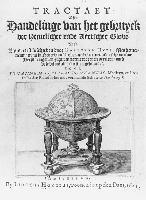 22. Tractaet, ofte handelinge van het gebruyck der hemelscher ende aertscher
globe
22. Tractaet, ofte handelinge van het gebruyck der hemelscher ende aertscher
globe
Author: Robert Hues
Printed at Amsterdam, in 1623
A new edition and translation from Latin to Dutch by Johannes Isacius Pontanus of the
Tractatus de globis by the English mathematician Robert Hues, first published in 1594.
The Dutch edition was published by Hondius.
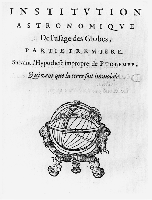 23. Institution astronomique de l'usage des globes et spheres celestes et terrestres, comprise
en deux parties, l'une, suivant l'hypothese de Ptolomee, qui veut que la terre soit immobile;
l'autre, selon l'intention de N. Copernicus, qui tient que la terre est mobile
23. Institution astronomique de l'usage des globes et spheres celestes et terrestres, comprise
en deux parties, l'une, suivant l'hypothese de Ptolomee, qui veut que la terre soit immobile;
l'autre, selon l'intention de N. Copernicus, qui tient que la terre est mobile
Author: Guillaume [W.J.] Blaeu
Printed at Amsterdam, in 1642
Blaeu divides his book into two sections - one assuming a stationary earth, the other adopting
the Copernican hypothesis of the earth in motion - but he makes it clear that the latter represents
his preference.
24. Recorder
By John Cousen, Huddersfield
c.1975
Treble recorder based on an illustration by Praetorius of 1619.
Length: 444 mm.
On loan from the Montagu Collection
25. Drum.
Reproduction baroque side drum.
Length: 520 mm, diameter: 459 mm.
On loan from the Montagu Collection.
26. Drumstick.
Length: 265 mm.
On loan from the Montagu Collection
27. Het Ierste Musyck Boexken.
Two part books, superius and tenor, the original edition being by Tielman Susato, Antwerp,
1551; the reproduction edition by Eugeen Schreurs and Martine Sanders (Peer, Belgium,
1989).
On loan from the Montagu Collection.
28. Standard weight
Marked: ANo DO 1588 EL Ao REG XXXo
An English bell-shaped 28-lb weight. In 1588, when Elizabeth I reformed the system of weights
on the avoirdupois standard, sets of standard weights were made for use throughout the
country.
Height: 200 mm
On loan from the Ashmolean Museum
29. Gauging rod
18th century
A jointed hardwood rule in three sections, with brass hinges, end pieces and inlaid
numbers.
Length: 1.1 m
Inventory no. 1002
30. Quart measure
Signed: De Grave London
Dated: 1817
An example of the Winchester quart measure, made for the 'Hundred of Rhyddland, County of
Flint'.
Height: 168 mm
Inventory no. 1003
31. Gallon measure
Dated: UNIV: OXON. 1737
A Queen Anne wine gallon measure. An Act of Parliament of 1706 defined the wine gallon
(which was different from the ale gallon) as: 'any round vessel (commonly called a cylinder)
having an even bottom and being 7 inches in diameter and 6 inches deep ... or any vessel
containing 231 in3 and no more' (Connor, p. 163).
Height: 175 mm; diameter: 190 mm
On loan from the Ashmolean Museum
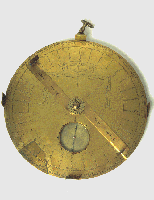 32. Holland circle
32. Holland circle
Dated: 1565
A surveying instrument of a type known as a 'Holland circle', Dutch, made in brass. Its basic
application is to measuring bearings with the pivoted alidade moving over three alternative scales
- a
circumferential degree scale, 32 points of the compass, named in Dutch and subdivided to
degrees, or
a double shadow square. The compass points were probably more familiar to the traditional
surveyor
than the scale only in degrees. An inset magnetic compass, with a target line offset for variation,
is for
orienting the instrument when taking bearings. In addition to the two pivoted sights, four fixed
ones
can form a surveyor's square. A shackle and suspension ring can be used to hang the instrument
vertically, when the alidade will indicate altitudes on the degree scale or the shadow square and
two
of the fixed sights will give the level. An inscription, 'DeLIneaVIt refeCItqVe MICheL
brVXeLLIs',
added to the alidade in modern times records the ownership of the collector Henri Michel and,
in the
form of a chronogram, the date 1930, which probably dates the fitting of the new alidade.
Diameter: 350 mm
Michel Collection; Billmeir Collection
Accession no. 57-84/125
33. Quadrant
c. 1700?
This English instrument is not a surveying quadrant, but its size is appropriate to the one in
The
Measurers and, with its fixed sights, plumb-line and degree and shadow-square scales on the
rim,
it could be used for measuring altitudes. Its main purpose, however, was for finding the time
from the
altitude of the sun. With a wooden case covered with tooled leather.
Radius: 300 mm
Lewis Evans Collection 5
34. Bushel measure
Dated: UNIVERSITAS OXON 1670
The Winchester bushel was a standard for dry goods introduced in the reign of Henry VII, but
first mentioned in statutes by an Act of 1670, the date on this example. For centuries the
Universities of Oxford and Cambridge were responsible for checking trading measures used in
their respective localities and so needed to have standard measures.
Diameter: 490 mm
On loan from the Ashmolean Museum.
35. Peck measure
The peck is a quarter bushel. This example was formerly in the possession of the Clerks of the
Market in Oxford and was deposited in the Ashmolean Museum in 1866.
Diameter: 372 mm
On loan from the Ashmolean Museum
36. Ell rule
Dated: 1786
An oak rule, thought to be German, with a shaped handle and brass fittings indicating two
different ells on opposite faces of the rule.
Length: 834 mm
Accession no. 77-21
37. Ell rule
18th century?
Wooden rule, possible Scandinavian, with triangular cross-section and metal end pieces. Divided
by brass insets into eighths and sixteenths. The rule has decorative carving on each face,
including an alphabet on one, and among the carved shapes is a pair of scissors.
Length: 542 mm
Accession no. 77-22
38. Scissors
Spring-mounted steel scissors, of the type depicted in The Measurers.
Length: 129 mm
Loaned from the Montagu Collection.
39. Yard rule
A wooden yard of octagonal cross-section with brass end caps.
Length: 915 mm
Inventory no. 1007
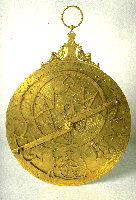
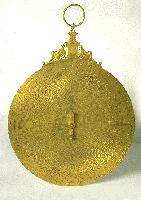
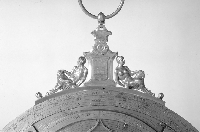
40. Astrolabe
Signed: Regnerus Arsenius Nepos Gemmę Frisij fecit Louanij anno 1565
Several features of this instrument are typical of Arsenius astrolabes - the figures supporting the
suspension piece, the italic script introduced by Mercator, but most distinctive of all is the
characteristic strapwork design used for the rete. In this case the rete has 36 stars. One latitude
plate survives and is engraved on either side for latitudes 45 and 51 degrees. Beneath the plates,
the mater carries a nautical square - 'Quadratum Nauticum' - for navigational calculations, such
as is illustrated and ascribed to Gemma in his version of Apian's Cosmographia. Instead
of the customary scales on the reverse, such as the shadow square and an equal-hour diagram,
this instrument has a beautifully executed example of Gemma's design of universal astrolabe, his
'astrolabum catholicum'.
Diameter: 289 mm
Roussel Collection
Lewis Evans Collection 2047
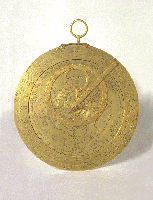
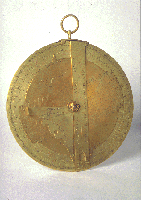
41. Astrolabe
Signed: Ęgidius cuiniet antuerpianus facieb. Ao 1560
This instrument relates closely to Gemma's editions of the Cosmographia of Apian. There
is a single plate, engraved on one side with a tablet of horizons, which links the time of the sun's
rising or setting to the latitude, and on the other with a geographical planisphere, centred on the
pole and extending to the Tropic of Capricorn. This planisphere uses the same projection as the
customary rete, but is a map of the earth rather than the heavens. It can be adjusted about the
centre, while above rotates a ring representing the ecliptic, engraved with the signs and degrees
of the zodiac. Eight star positions are marked by pointers within the ecliptic. An index arm, also
pivoted at the centre, has a latitude scale. The motion of the ecliptic ring thus represents the daily
paths of the sun throughout the year, the sun's position in the ecliptic for any date being given
by a zodiacal calendar on the mater. The index arm and scale of hours on the mater can be used
to find local times. The reverse side has a type of sundial based on the organum Ptolemei
projection, as described in the Cosmographia; in addition to the time, it gives the times
of sunrise and sunset and the duration of twilight.
Paper versions of both these instruments are, for example, in the 1584 Antwerp edition of the
Cosmographia (catalogue no. 2); the geographical planisphere in its paper form even has
a tablet of horizons beneath the planisphere.
Egidius Coignet was the father of Michael.
Diameter: 215 mm
Lewis Evans Collection 2027
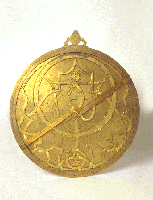
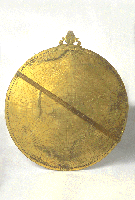
42. Astrolabe
Signed: Thomas II 1559 [i.e. Thomas Gemini]
The similarity in style between this astrolabe, made in London for Queen Elizabeth I, and those
from the Arsenius workshop in Louvain is particularly clear from the design of the rete, which
marks the positions of 23 stars. Like the Arsenius astrolabe (catalogue no. 40) the inside of the
mater has a nautical square and the back has Gemma's design of universal astrolabe. The single
surviving plate has a tablet of horizons on one side and on the other scales generally found on
the back of an astrolabe: a zodiacal calendar scale, a shadow square and a conversion diagram
for equal/unequal hours.
One side of the suspension piece carries the arms of Elizabeth I and the initials 'E R', and the
other is inscribed: 'Elizabeth Dei Gratia Anglię Francię & Hibernię Regina'. A further
inscription on the plate indicates that the astrolabe was given to the University by Nicholas
Greaves in 1659 for the use of the Savilian Professors. It had been the property of Nicholas's
brother John Greaves, Savilian Professor of Astronomy, who had taken it on an expedition to the
Levant in 1637-40.
Diameter: 355 mm
Provenance: Elizabeth I; John Greaves, Nicholas Greaves; University of Oxford, collection of
the Savilian Professors; University Observatory, Oxford.
Accession no. 36-6
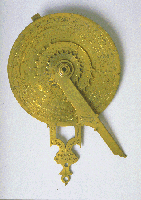
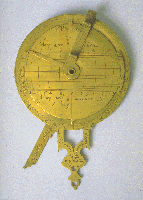
43. Nocturnal and sundial
Signed: Michael Coignet fe
Dated: 1598
The nocturnal side has a zodiacal calendar and date scale used to set the scale of hours (divided
to 15 minutes) on a volvelle plate with an index arm. For finding the time at night, with the
volvelle plate set to the date, the instrument is held vertically so that the pole star is viewed
through the central hole and the long index arm turned to coincide with the 'pointer' stars of the
Little Bear. Its position on the time scale then gives the time, which can be ascertained by
feeling, since the hour teeth (at 4 to 12 to 8) can be counted from the pointer at 12. The hour plate
also has a scale for Easter: 'Epacte Anno. 98' and there is an inner 24-hour volvelle plate. The
other side has the organum Ptolemei form of sundial - the same type as that on the
geographical astrolabe by Egidius Coignet (catalogue no. 41) and as described in Gemma's
editions of Apian's Cosmographia.
Diameter: 108 mm
Lewis Evans Collection G. 78
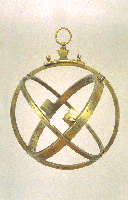 44. Astronomical rings
44. Astronomical rings
Signed: Nepos Gemmę Frisij Louanij fecit 1567
An example of the portable equatorial instrument designed by Gemma Frisius and made by his
nephew Gualterus Arsenius, signed not in his own name but as the nephew of the famous
mathematician. The signature is on the meridian ring, which is marked 'MERIDIANVS' and
'Meridianus' and has one quadrant engraved with a latitude scale divided to single degrees. This
is for setting the position of the suspension shackle and ring: the graduated section of the
meridian ring is pierced by a series of threaded holes and a brass plate on which the shackle is
mounted has a longitudinal slot so that it can be fixed by two screws at any position on the
latitude scale. The other two rings are pivoted on the meridian ring. One, at zero degrees and
marked 'Ęquator', folds out to stop at right angles to the meridian ring; the other, innermost ring
pivots freely about an axis set at 90 degrees. This ring - the declination ring - has a circular band
of brass moving friction-tight on its inner surface and to this band are attached a pair of
diametrically-opposed vanes with pinhole sights and pointers. When the instrument is adjusted
for the local latitude and suspended in the meridian with the upper pivot of the declination ring
towards the north, its axis points to the celestial pole (the upper pivot is marked 'Polus Arcticus',
the lower 'Polus Antarcticus') and the equatorial ring lies parallel to the equator. One side of the
declination ring is half divided 90 to 0 to 90 degrees and has a solar declination scale with zodiac
symbols on either side of the equator; the other side of the ring has an hour scale divided to 4
minutes, while the rim is marked for the declinations of named stars. The inner band carries a
zodiac scale with the positions of named stars marked in the zodiac (the engraving style on the
band is different from that on the body of the instrument). The equatorial ring is half graduated
on both sides with an hour scale divided to 4 minutes and has the signs of the zodiac on the rim,
while a quadrant on one side carries shadow square scales marked 'VMBRA RECTA' and
'VMBRA VERSA' used for surveying (fig. 19).
Diameter: 111 mm
Michel Collection; Billmeir Collection
Accession no. 57-84/24
45. Les principles d'astronomie et cosmographie: avec l'usage du globe. Le tout cõposé par
Gemma Frizon ... Plus, est adiousté l'usage de l'anneau Astronomic, par ledict Gemma
Frizon
Author: Gemma Frisius
Printed at Paris, in 1556
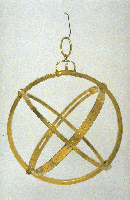 46. Astronomical rings
46. Astronomical rings
Signed: ALBERTO . IMPERATORIS . FILIO . IMP : FRATRI * ISABELLĘ . PHILIPPI .
REGIS . FILIĘ . PHIL : REGIS . SORORI . ĘTERNVM . REGERE . IA . D . SVCCA.
Dated: 1600
As the inscription records, the instrument was presented to Albert, Archduke of Austria
(1559-1621), to whom the manuscript tract by Michael Coignet on the pantometric rules was
dedicated (see figs 7 & 8). Albert was son of Emperor Maximilian II and the Infanta Isabella
Clara Eugenia, daughter of Philip II of Spain. De Succa was an instrument maker in
Antwerp.
Tycho wrote in his Astronomiae instauratae mechanica of 1598 that, as an astronomical
instrument, Gemma's rings was no more than a toy, but he conceded that it did make a useful
sundial. Here the design has shed any pretensions to position measurement and has indeed
become a dial. The declination ring has only a scale of dates, equivalent to a solar declination
scale, and the scale portion of the ring is pierced by a slot in which is moved a decorated cursor
with a hole for the sun's rays; on the opposite side of the ring, at the point where the solar
declination angles are subtended, there is a target for the light admitted by the hole.
Correspondingly, the equatorial scale has a scale of hours, subdivided to 4 minutes. With the
latitude and solar declination adjustments properly made, the declination ring has to be turned
so that the spot hits the target, the instrument being suspended freely, and this is possible only
when the meridian ring is in the meridian. An index line, 'LINEA HORARIA', on the back of the
declination ring then indicates the time on the equatorial ring.
Diameter: 158 mm
Mercator and McVitty Collections; Billmeir Collection Accession no. 57-84/180
47. Armillary Sphere
16th-20th centuries?
The exhibition ends with a puzzling and ambiguous instrument which links the collecting
activities of the 16th and 20th centuries. Its current display label suggests that it might be
Flemish, but it awaits thorough examination and has yet to be fully understood. The upper part
of the instrument is a sixteenth century armillary sphere, but a very complex one. In addition to
the usual circles of the celestial sphere, adjustable for latitude and rotatable on a polar axis, there
are sixteen star pointers, an ecliptic axis of the type described in Ptolemy's Almagest and
what seems to be an adjustment for trepidation - a supposed oscillatory motion of the equinoxes.
This is very much a collector's item of the sixteenth century: its use may have extended to
teaching or demonstration, but it was not a practical mathematical instrument. The lower part has
a bronze figure of a kneeling man in a loincloth - perhaps meant to be Atlas - supporting the
world on his head and supported himself by a modern turned brass stand in two tiers,
incorporating a magnetic compass and three feet ornamented with satyrs. If the upper part, in its
geometrical complexity, represents the ambitions of a wealthy patron to associate himself with
the most sophisticated of the mathematical sciences, the lower was designed to appeal to much
later aesthetic expectations.
Height: 450 mm
Billmeir Collection
Accession no. 57-84/23a
Contents
Museum home page
(c) Museum of the History of Science, Broad Street, Oxford, England.

 1. The Measurers
1. The Measurers 








 4. Gerardus Mercator and Iudocus Hondius
4. Gerardus Mercator and Iudocus Hondius 5. Mercator & Hondius edition of Ptolemy's Geographia
5. Mercator & Hondius edition of Ptolemy's Geographia 6. Annuli astronomici
6. Annuli astronomici 7. De annuli sphęrici fabrica et usu
7. De annuli sphęrici fabrica et usu 8. De genuino usu utriusque globi tractatus
8. De genuino usu utriusque globi tractatus 10. Primum mobile, astronomice, sciographice, geometrice, et hydrographice ...
Editio nove, ab innumeris mendis vendicata, et instrumentis mathematicis aucta ą
Guilielmo Blaeu
10. Primum mobile, astronomice, sciographice, geometrice, et hydrographice ...
Editio nove, ab innumeris mendis vendicata, et instrumentis mathematicis aucta ą
Guilielmo Blaeu 11. Cruciform sundial
11. Cruciform sundial

 22. Tractaet, ofte handelinge van het gebruyck der hemelscher ende aertscher
globe
22. Tractaet, ofte handelinge van het gebruyck der hemelscher ende aertscher
globe 23. Institution astronomique de l'usage des globes et spheres celestes et terrestres, comprise
en deux parties, l'une, suivant l'hypothese de Ptolomee, qui veut que la terre soit immobile;
l'autre, selon l'intention de N. Copernicus, qui tient que la terre est mobile
23. Institution astronomique de l'usage des globes et spheres celestes et terrestres, comprise
en deux parties, l'une, suivant l'hypothese de Ptolomee, qui veut que la terre soit immobile;
l'autre, selon l'intention de N. Copernicus, qui tient que la terre est mobile 32. Holland circle
32. Holland circle








 44. Astronomical rings
44. Astronomical rings 46. Astronomical rings
46. Astronomical rings